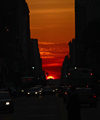FEILE-FESTA
Spring 2014
Poetry
My Grandmother’s Sheets
- M. Bouvard
In My Sicilian Cart
- S. Buttaci
Irish Prayer
- N. Byrne
In the VA Hospital
- M. Candela
My Immigrant Grandpa’s Cottage
- A. Curran
Assurance
- F. Diamond
A Dream of Joe
- C. Dodds
He Never Shut Up
- L. Dolan
La Sicilia
- J. Going
A Kind of Sacrament
- T. Johnson
I’m Writing Brochures for Travel Companies
- M. Lisella
Grandmothers Speak
- P. McClelland
All the Way
- J. McKernan
Cahir Castle
- K. Mitchell-Garton
Return to New York
- T. Peipins
Memorabilia
- F. Polizzi
Lu Friscalettu/
The Reed Pipe
- N. Provenzano
At the Protestant Cemetery
- D. Pucciani
Evelyn McHale
- J. Raha
Gerry Summons Up The Past
- G. Sarnat
Doing Her Proud
- M. Trede
My Daughter Wears Her Evil Eye to School
- L. Wiley
Finbarr Enters the Poet’s Mind
- H. Youtt
Beyond the Animal Farm
- C. Yuan
FEILE-FESTA
Spring 2014
Prose
Plenty of Places
- A. Annesi
The Italian Cultural Garden
- M. De Julio
Dancing with the Best of Them
- J. Duncan
Doña Carmen Dreams Of San Vito
- G. Fagiani
Stones and Roses
- J. Going
Review of Leonard Covello’s The Heart is the Teacher
- R. Holz
Crates
- J. Kierland
Review of Anthony Di Renzo’s Novella, Trinàcria: A Tale of Bourbon Sicily (Guernica, 2013)
- T. Zeppetella
Featured Artist
Andy Kover
BIOGRAPHIES
Contributors
|
The Italian Cultural Garden Mussolini came to Cleveland in 1930 to inaugurate the Italian Cultural Garden. The bust of Virgil that his government gave to the city, once atop a pillar from the Forum in Rome, is no longer there – stolen by vandals in the 1960s and sold at auction several times over, most recently by a man now in a New York State penitentiary, convicted of robbing Tiffany glass from a gravesite. This is what Gino C. and his wife, Liliana, tell me over a lunch of Italian cold cuts and slices of fruit and cheese, which they’ve prepared for me in their home in Mayfield Heights.
Mussolini never came to Cleveland to inaugurate the Italian Cultural Garden. Newspaper accounts don’t place him there, Columbus Day 1930, the 2000th anniversary of the birth of Virgil, and surely they would have. The Cleveland Plain Dealer reports on the three thousand members of Italian societies who turned out on this unusually warm, October day. A message from President Herbert Hoover was read and one from Premier Mussolini. Grainy photographs show the inaugural ceremony, men in hats and suit coats, but no Mussolini, no grand entrance by Il Duce into the city of Cleveland, bearing gifts from the Italian people.
No matter, I can’t dissociate Mussolini from the Italian Cultural Garden. I’ve burnished this detail in my mind and now it’s real for me. It’s real in the same way as the heartscape I see in the wide embrace of circular steps leading from the lower garden level to the upper – hardscape’s the technical term for stone landscape design, but I misunderstood.
Massive stone piers stand as sentinels to the upper level, while the radiating wall of a terrace below, on the lower more intimate level, offers a seat for contemplation and conversation. There are sculptural plaques with the names of Giotto, Michelangelo, Petrarca, Verdi, Da Vinci, and Marconi on either side of a high retaining wall. And water cascades down from the central fountain above, designed in the Roman style, after a similar fountain by Giacomo della Porta in the Piazza Colonna.
All this, plus the curved outlines of the crataegus hedges, the groups of Lombardy poplars and the bosques of European sycamores, immediately inspired Liliana to write a poem when she first saw the garden. She wanted to capture the rush of emotion that flooded her as she stood before the formal terraces, the fountain, the monument to Italian culture. Being from Rome, Liliana says she couldn’t have lived in the small coal-mining town in Western Pennsylvania where Gino’s family had originally settled. She needed to feel the spirit of her country: The Italian Cultural Garden, set in the two-mile stretch of green from University Circle to Lake Erie, let her breathe again. |
